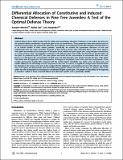Por favor, use este identificador para citar o enlazar a este item:
http://hdl.handle.net/10261/65477COMPARTIR / EXPORTAR:
 SHARE SHARE
 CORE
BASE CORE
BASE
|
|
| Visualizar otros formatos: MARC | Dublin Core | RDF | ORE | MODS | METS | DIDL | DATACITE | |

| Título: | Differential allocation of constitutive and induced chemical defenses in pine tree juveniles: A test of the optimal defense theory |
Autor: | Moreira Tomé, Xoaquín CSIC ORCID; Zas Arregui, Rafael CSIC ORCID; Sampedro Pérez, Luis CSIC ORCID | Fecha de publicación: | 2012 | Editor: | Public Library of Science | Citación: | PLoS ONE 7 (3): e34006 (2012) | Resumen: | Optimal defense theory (ODT) predicts that the within-plant quantitative allocation of defenses is not random, but driven by the potential relative contribution of particular plant tissues to overall fitness. These predictions have been poorly tested on long-lived woody plants. We explored the allocation of constitutive and methyl-jasmonate (MJ) inducible chemical defenses in six half-sib families of Pinus radiata juveniles. Specifically, we studied the quantitative allocation of resin and polyphenolics (the two major secondary chemicals in pine trees) to tissues with contrasting fitness value (stem phloem, stem xylem and needles) across three parts of the plants (basal, middle and apical upper part), using nitrogen concentration as a proxy of tissue value. Concentration of nitrogen in the phloem, xylem and needles was found to be greater higher up the plant. As predicted by the ODT, the same pattern was found for the concentration of non-volatile resin in the stem. However, in leaf tissues the concentrations of both resin and total phenolics were greater towards the base of the plant. Two weeks after MJ application, the concentrations of nitrogen in the phloem, resin in the stem and total phenolics in the needles increased by roughly 25% compared with the control plants, inducibility was similar across all plant parts, and families differed in the inducibility of resin compounds in the stem. In contrast, no significant changes were observed either for phenolics in the stems, or for resin in the needles after MJ application. Concentration of resin in the phloem was double that in the xylem and MJ-inducible, with inducibility being greater towards the base of the stem. In contrast, resin in the xylem was not MJ-inducible and increased in concentration higher up the plant. The pattern of inducibility by MJ-signaling in juvenile P. radiata is tissue, chemical-defense and plant-part specific, and is genetically variable. © 2012 Moreira et al. | URI: | http://hdl.handle.net/10261/65477 | DOI: | 10.1371/journal.pone.0034006 | Identificadores: | issn: 1932-6203 e-issn: 1932-6203 |
| Aparece en las colecciones: | (MBG) Artículos |
Ficheros en este ítem:
| Fichero | Descripción | Tamaño | Formato | |
|---|---|---|---|---|
| Moreira_Differential_allocation...pdf | 242,74 kB | Adobe PDF |  Visualizar/Abrir |
CORE Recommender
PubMed Central
Citations
10
checked on 21-mar-2024
SCOPUSTM
Citations
55
checked on 15-abr-2024
WEB OF SCIENCETM
Citations
53
checked on 26-feb-2024
Page view(s)
348
checked on 22-abr-2024
Download(s)
206
checked on 22-abr-2024
Google ScholarTM
Check
Altmetric
Altmetric
Artículos relacionados:
NOTA: Los ítems de Digital.CSIC están protegidos por copyright, con todos los derechos reservados, a menos que se indique lo contrario.
